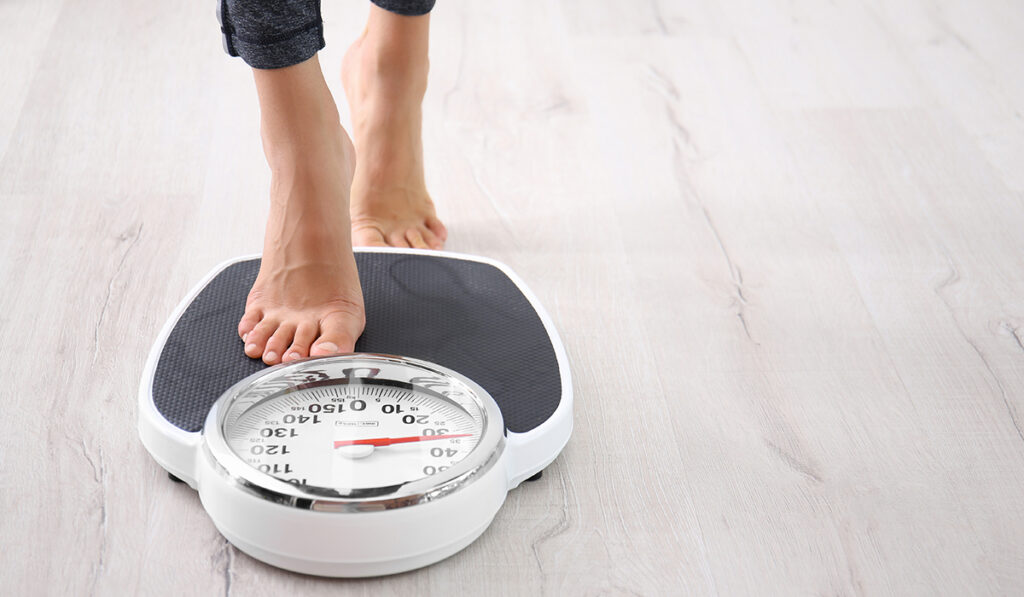Nutrition is a key to managing midlife hormonal shifts. Hormonal changes occur throughout our lives. But we most often notice declines in our sex hormones in middle age. Such changes can affect metabolism, weight loss, and more. Despite these inevitable hormonal shifts, you can use nutritional and lifestyle strategies to support hormonal balance and help reach your goals — so that middle age has nothing on you.

Why Hormones Decline As We Age
Hormonal changes in mid-life are a fact of life. Both estrogen and testosterone are important for the male and female body. However, hormonal balance for women involves a higher ratio of estrogen to testosterone. For men the ratio favors testosterone. So what happens as we age?
For women, estrogen will have declined by half around your last menstrual period. Other hormones, including progesterone also decrease. Keep in mind that perimenopause can last for nearly a decade before you reach menopause, which is an absence of a period for 12 months. Menopause is most often reached naturally by your early 50s. Men experience something similar called andropause. Testosterone begins to steadily decrease in the male body by age 30.

What Lifestyle Factors Play A Role In Hormone Imbalance
Many lifestyle factors can cause or exacerbate hormonal imbalances at any age. Likewise, engaging in healthier habits can help improve balance and lessen the effects of hormonal shifts.
Body fat percentage. A higher body fat percentage, consistent with obesity, can drive testosterone production in women and estrogen production in men. Fat loss can help balance hormones.
Muscle mass. Our muscle mass begins to decline in middle age. But muscle can support hormonal balance for both men and women, metabolism, and overall metabolic health. Resistance training can help you gain and preserve muscle mass.
Smoking. For women, smoking can contribute to early menopause and hormonal concerns. For men, smoking can drive testosterone decline.
Alcohol use. Overconsumption of alcohol can fuel hormonal imbalances.
Toxin exposure. Several toxins we’re exposed to in our everyday lives have been labeled as endocrine-disrupting chemicals, meaning they can contribute to hormonal imbalances. Eliminating these completely would be impossible, but we can take steps to reduce our exposure.
Diet. Diet can either help support hormonal balance or cause an imbalance.

How Hormone Imbalances Can Impact Metabolism & Weight Loss
Our hormone levels and their changes impact our metabolic health, our metabolism, and our body composition.
For women, a decline in estrogen, progesterone, and other hormones can increase androgens, such as testosterone. Excess androgen levels in women can lead to weight gain, especially around the belly. For men, a decrease in testosterone can lead to an increase in estrogen, which can contribute to extra pounds and other metabolic health issues.
Another factor: estrogen for women and testosterone for men are somewhat protective against insulin resistance. However, midlife hormonal changes, for both men and women, can contribute to this phenomenon. Insulin resistance occurs when, over time, high blood sugar levels and corresponding surges in insulin lead cells to ignore insulin’s signaling. Insulin resistance is associated with cravings, weight gain, and obesity.

5 Nutritional Considerations That May Improve Hormone Balance
In the face of mid-life hormonal changes, or at any time, we do have some nutritional strategies that can help support hormone balance.
Eat for stable blood sugar. Frequent blood sugar spikes over time can contribute to insulin resistance. And since midlife hormonal changes already put us at a greater risk for insulin resistance, strategies to prevent it can help.
Try reducing your intake of refined carbohydrates and added sugars, all of which tend to spike blood glucose. When you do eat carbohydrates, pair them with protein, fat, and fiber to lessen the chance of a glucose spike.
Blood sugar spikes are often followed by reactive hypoglycemia, when the body overcorrects the spike and blood sugar plummets. These blood sugar crashes can lead to cravings for starchy or sweet foods, which can impact your health goals.
Eat a variety of fruits and veggies. Fruits and veggies are loaded with micronutrients, and micronutrients help support hormonal processes.
Up your protein intake. Protein helps support muscle protein synthesis, which helps us build muscle from resistance training. Remember, muscle helps support hormonal balance. Plus, muscle is protective against insulin resistance. Muscle also boosts your calorie burn.
How much do you need? The recommended daily allowance is about 0.4 grams of protein per pound of bodyweight. But if you’re trying to support hormonal health and muscle mass, you need to double that to at least 0.8 grams of protein per pound of bodyweight. Be sure that you are consuming complete proteins, forms that contain all essential amino acids.
Eat more healthy fats. In past decades, fats got a bit of a bad rap. But healthy fats — like those in avocados, fish, nuts, olives, olive oil, and grass-fed red meat — are excellent for your health and crucial for hormone balance in both men and women.
Avoid ultra-processed foods as much as possible. Ultra-processed foods are often laden with added sugar and other additives. Plus, they may disrupt hormonal balance. They also tend to be packaged with materials that contain endocrine-disrupting chemicals, which could further lead to hormonal imbalance.

Takeaway
Middle age tends to be when we start to notice hormonal imbalances from shifts in levels. But dietary and lifestyle changes can support your hormones and overall health. You got this!
Find the nutrition you need on this week’s menu.
SHOP NOW >






